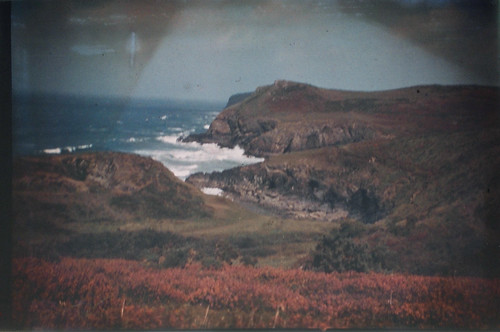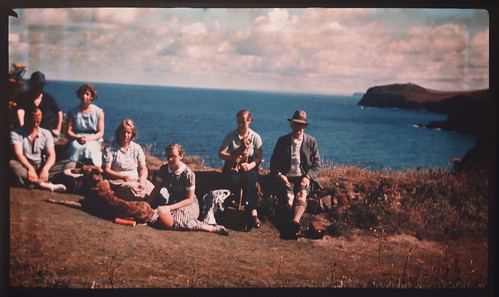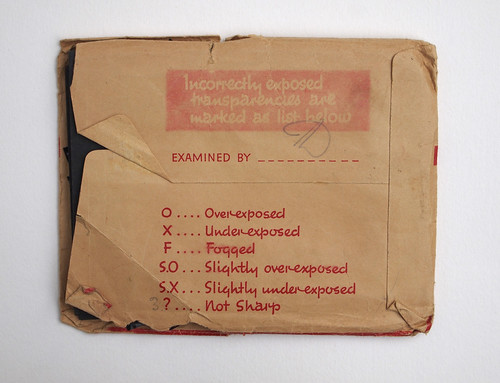 |
| Dufaycolor transparency, 1937 |
In my posts about
making colour images from monochromatic separation negatives, I wrote about one early technological approach to capture colour in photography. Although advanced cameras were produced which could simultaneously expose three plates, the ability to capture a colour image in a single exposure was a highly desirable goal, and one which produced a number of different processes at the end of the 19th and the early 20th century. One of these was
Dufaycolor, and the images illustrating this post come from my partner's family when I was given the opportunity to digitize the original photographs.
The Dufaycolor process was introduced as cine-film in 1932, followed by rollfilm for still cameras in 1935 when Ilford acquired an interest in the company. The Dufaycolor system was based on an earlier plate process, Louis Dufay's Dioptichrome plate from 1909, itself preceded by Diopticolore. This was one of many
additive colour screen processes that were developed from the end of the 19th century, partly enabled by increases in spectral sensitivity which allowed photographic emulsions to capture a wider range of visible light. These colour processes all worked in essentially the same way: a photographic emulsion is exposed through a screen comprised of minute colour filters (using either a separate screen plate or as an integral plate containing both filter screen and emulsion), and then reversal processed to produce transparencies. The best known of these processes is the Lumière
Autochrome, which used a mosaic of dyed potato starch grains coloured red-orange, green and violet. The grains had a tendency to form irregular clumps which gives Autochromes a Pontillist appearance. Most of the other screen processes used mechanically ruled lines, however, either in parallel (as were many of the early and crude attempts) or with the lines crossing at perpendicular angles, which is the case with the Dufaycolor system, where the screen or
réseau comprises red lines interspersed with rows of green and blue rectangles. These lines, at 500 to the inch, are fine enough not to be visible by the naked eye, but would be evident when used for cine-film and projected, although many examples of Dufaycolor cine film I've found online are not of sufficient quality to resolve this detail. Dufaycolor, as the last additive screen-film process to appear on the market was durable and popular enough to survive into the late 1950s, although it was unable to compete with the technologically superior
subtractive colour Kodachrome and Agfacolor, which essentially set the template for all future colour photographic processes.
 |
| Dufaycolor transparency c.1937 |
Using extension tubes gave enough magnification to create the image below, a detail of the dog which clearly shows the ruled screen. As the transparency above is about 6.5cm tall, the enlarged detail is roughly 5mm square, which demonstrates how fine the lines of the réseau are. This is around double the resolution of earlier screen processes, such as
Joly plates, the first to be produced commercially, and the Dioptichrome plates that Dufaycolor itself had evolved from, and also finer than standard commercial printing today. Incidentally, when a point source of light is viewed through a Dufaycolor transparency, the réseau diffuses the light into a series of banded highlights, which may be one way of identifying the process in the absence of other information.
 |
| Macrophotograph of Dufaycolor image showing detail of the réseau |
The transparencies had been kept in an original envelope. Although the reversal processing needed could have been accomplished by any competent lab or amateur, Dufaycolor films had a dedicated 'processing station' (it's unclear whether this service was included, "process paid", as part of the cost of the film), with the address on the envelope, although the envelope itself shows no evidence of how it had been returned to the customer, either being posted directly, or from a local lab.
 |
| Dufaycolor envelope |
 |
| Dufaycolor transparency in mount |
The transparencies were originally supplied in mounts; in the image above, the mount provides a degree of cropping to make the horizon more level, while silvering around the edge of the frame is quite evident, which appears as dark brownish marks on the transparency below. As the photographic emulsion is exposed through the film base and the réseau, the correct orientation is to view the transparency from the emulsion side. The image at the top of this post shows that the exposed emulsion surfaces have suffered more from silvering: it is apparent that the clearer portion of the photograph is due to another picture lying on top at an angle, perhaps for a number of years.
 |
| Dufaycolor transparency, 1937 |
The Dufaycolor transparencies proved to be too dense to scan, so instead I photographed them on a light box. There were two different sizes of transparency, 6x9cm and 6.5x11cm, which relate to 120 and 116 medium format rollfilms. The images all show a lack of sharpness to a varying degree, which may be from focus problems, or film flatness. The film was rated 10 ISO, and, judging by the tilting horizon lines in many shots, these were all taken hand held, which would have meant slow shutter speeds and relatively wide aperture (by comparison, at the date these photographs were taken, Ilford had introduced the first HP film, at 160 ISO, and Selochrome was rated 100). Dufaycolor was faster than Autochrome, a version of which had been released in rollfilm format, but colour filters always reduce the amount of light reaching the emulsion (according to
Colour Photography: The first hundred years 1840-1940, Dufaycolor had a transmission rate of 21%, compared to Autochrome's 7.5%, which meant that 92.5% of the light entering the camera when exposing an Autochrome plate was absorbed by the filter layer
before reaching the photographic emulsion). Some of these screen processes struck a compromise between colour saturation and the speed of film or plate: the less intense the colours in the filter screen, the more light would be available to reach the emulsion.
 |
| Dufaycolor envelope (back) |
Many of the images are underexposed and not very sharp - the back of the envelope has a series of abbreviations (rather in the manner of the stickers that used to come back with photos from Boots and other D&P establishments): on the image of the mounted transparency above, 'S.X.' is marked in the top right hand corner. Although the transparencies had been kept in one envelope, as there are two different sizes, and the Dufaycolor rollfilm came in rolls of six frames, the fifteen photographs must be from at least three rolls of film. Intriguingly, the shot below shows two cameras being held, one appears to be a box camera in a case, the other a folding camera - the white highlight being the brilliant finder rather than the lens. It is just conceivable that both cameras in the picture were also loaded with Dufaycolor and that all the transparencies in the envelope were shot simultaneously, on two occasions, one with all the family in Cornwall where they stayed in New Polzeath in summer 1937, the other possibly by the Thames, where the family had a house near Henley, which appears in some of the other photographs.
 |
| Dufaycolor transparency c.1937 |
In photographing the transparencies, I attempted to keep the colours as close to the original values from camera to screen, while bringing out more detail from the underexposed shots. The colours do have a distinct look quite unlike modern films, due to the dyes used in the process, but these colours have proved very durable.
 |
| Dufaycolor transparency 1937 |
 |
| Dufaycolor transparency c.1937 |
 |
| Dufaycolor transparency c.1937 |
 |
| Dufaycolor transparency c.1937 |
Sources/further reading:
Colour Photography: The first hundred years 1840-1940, Brian Coe, 1978
Dufaycolor on Photomemorabilia
Dufay entry on Camera-wiki
Early colour photography PDF from the National Media Museum












How wonderful! Thank you for the bit of education about this color process, and for sharing these images.
ReplyDeleteI have a Dufaycolor Transparency Viewer that is a black painted wooden box with mirror and frosted glass, to use daylight to view the picture.
ReplyDeleteGreat save of those transparencies. Also appreciated your explanation of the Dufaycolor process. While researching my little Argus-M, I found ads in which the company was promoting Dufay cine film respooled onto 828 reels for the camera. The Argus-M's film mask was, in fact, the same size as 35mm so that the cine film's edge perforations would not intrude into the frame. The re-spooled film was also a bit longer than standard 828, permitting 12 exposures in full-frame and more when the Argus-M's barndoors closed the film mask down to half-frame.
ReplyDeleteDufaycolor provided really subtle colour rendition when care was taken over exposure and subject. The blues and greens in particular render very well. Look at "Sons of the Sea" (1939) for how well green tones reproduce. That film is a great showcase for the process, although the lighting cameraman must have pulled his hair out over the high-contrast scenes where a white naval uniform is shown in the same shots as a chap with a dark business suit. Look carefully, and you'll see the "white" uniforms are not actually white - but still, pushing the latitude of the film stock to its absolute limits.
ReplyDeleteFelt great to know internet has still amazing blogs like this.
ReplyDeletebest-photo-light-boxes